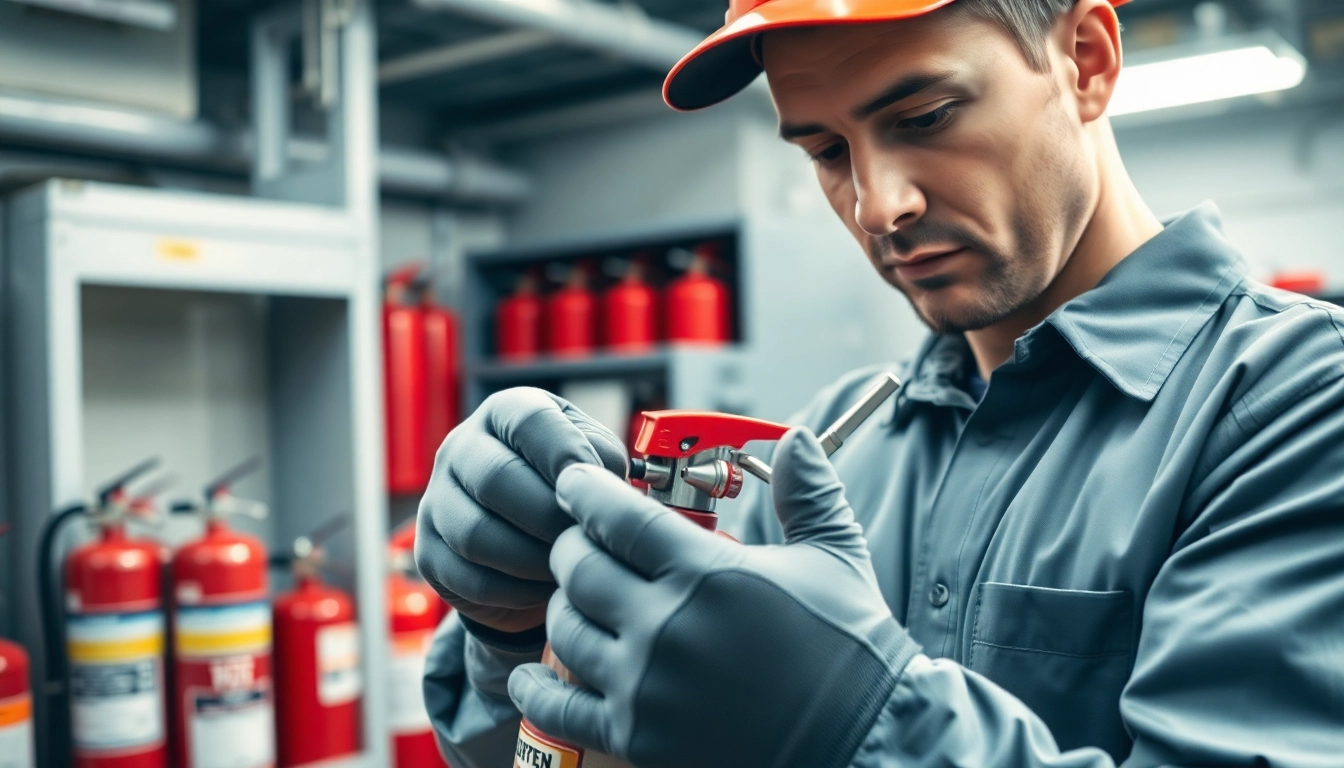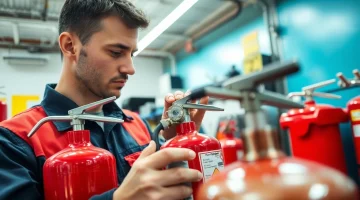
Essential Guide to Fire Extinguisher Maintenance: Steps and Best Practices
Understanding Fire Extinguisher Maintenance
Fire extinguishers are crucial safety devices designed to help combat small fires before they escalate into full-blown disasters. However, owning a fire extinguisher is not enough; proper fire extinguisher maintenance is essential to ensure they function correctly when needed. Understanding the nuances of fire extinguisher maintenance involves knowing its definition, significance, legal obligations, and best practices.
What is Fire Extinguisher Maintenance?
Fire extinguisher maintenance involves the routine and systematic care, inspection, and servicing of fire extinguishers. This maintenance includes both visual inspections and physical checks to ensure that the device is in proper working order and can effectively quell a fire. Maintenance activities can range from simple monthly visual checks to more comprehensive annual inspections and hydrostatic testing every few years.
Importance of Regular Fire Extinguisher Maintenance
Regular maintenance of fire extinguishers is vital for several reasons:
- Safety Assurance: Regular checks ensure that fire extinguishers will work as intended during an emergency.
- Compliance: Many jurisdictions have legal requirements regarding the maintenance and inspection of fire safety equipment, including fire extinguishers.
- Cost-Efficiency: Preventative maintenance can catch potential issues before they result in costly repairs or replacements.
- Insurance Compliance: Many insurance policies require evidence of regular maintenance for fire safety equipment, impacting claims in case of incidents.
Legal Requirements for Fire Extinguisher Maintenance
It’s crucial to understand that fire extinguisher maintenance is often governed by local, state, and federal regulations. For instance, the Occupational Safety and Health Administration (OSHA) mandates that fire extinguishers must undergo annual inspections, which must be documented. The National Fire Protection Association (NFPA) recommends that specific types of extinguishers undergo hydrostatic testing every 5 to 12 years, depending on the type and model. Adhering to these regulations not only ensures compliance but also enhances safety across premises.
Key Steps in Fire Extinguisher Maintenance
Visual Inspections: What to Look For
Monthly visual inspections are the first line of defense in ensuring fire extinguishers are serviceable. During these inspections, personnel should look for:
- Accessibility: Ensure extinguishers are easily reachable and not obstructed.
- Condition: Check for physical damages such as dents, rust, or leaks.
- Pressure Gauge: Verify that the gauge indicates the appropriate pressure level (in the green zone).
- Labels and Instructions: Ensure that instructions are readable and intact, and that the inspection tag is current.
Routine Maintenance Schedule
A comprehensive maintenance schedule should include:
- Monthly Visual Inspections: As mentioned, these are crucial for ongoing safety checks.
- Annual Inspections: An experienced technician should conduct these thorough checks, which may include the following:
- Verification of operational components
- Refilling or recharging extinguishers as necessary
- Replacing any faulty parts
- Hydrostatic Testing: Conducted every 5 to 12 years, depending on the type, to ensure the integrity of the extinguisher’s cylinder.
Common Issues and Solutions
During the maintenance process, common issues may arise:
- Dents and Damage: If an extinguisher exhibits significant physical damage, it may need to be replaced.
- Low Pressure: This may indicate a leak or the need for recharging. It’s essential to rectify this immediately.
- Corrosion: If corrosion is present, it may warrant a replacement of the unit, especially if it compromises functionality.
- Expired Units: Fire extinguishers that are past their expiration date must be serviced or replaced to remain compliant and effective.
Fire Extinguisher Maintenance Checklist
Monthly Inspection Checklist
For effective and straightforward oversight, a checklist for monthly inspections may include:
- Accessibility of the extinguisher
- Visibility and readability of the instructions
- Checking for physical damage
- Confirming proper pressure level
- Inspection tags should be up-to-date and correctly filled out
Annual Maintenance Requirements
Annual inspections involve a thorough review of the extinguisher, which should be documented as follows:
- Detailed checks on each component of the extinguisher
- Verification of the safety seals and tamper indicators
- Electrical and mechanical parts functionality check
- Documentation of any repairs made or issues found, along with corrective actions taken
Documentation and Record Keeping
Maintain detailed records of all inspections and maintenance activities, which should include:
- Date of inspection
- Name of the technician or responsible personnel
- Details of any issues found and actions taken
- Next scheduled maintenance date
Who Should Perform Fire Extinguisher Maintenance?
Certified Professionals vs. In-House Personnel
While minor visual inspections can often be performed by trained in-house staff, complex maintenance tasks, including annual inspections and hydrostatic testing, should be carried out by certified professionals. Certified technicians have the requisite training and understanding of fire safety regulations to ensure comprehensive inspection and maintenance of fire extinguishers.
Choosing a Fire Safety Service Provider
When selecting a fire safety service provider, consider the following:
- Certifications: Ensure they are certified by relevant authorities, such as the National Fire Protection Association (NFPA) or the National Association of Fire Equipment Distributors (NAFED).
- Experience: Look for providers with extensive experience in the industry and a solid track record of providing quality service.
- Reputation: Research reviews and testimonials from previous clients to gauge reliability and service quality.
- Compliance Knowledge: Ensure they are knowledgeable about local regulations and can help maintain compliance with safety laws.
Training for Staff on Fire Safety
Training employees on fire safety and proper extinguisher use is vital. Regularly scheduled fire drills that incorporate the use of extinguishers can bolster staff confidence and readiness in case of an emergency. Consider the following training elements:
- Identification of different types of fire extinguishers and their applications
- Demonstration of proper usage techniques and safety precautions
- Regular refresher courses and drills to maintain competence and readiness
Costs Associated with Fire Extinguisher Maintenance
Typical Costs for Maintenance Services
The costs for fire extinguisher maintenance can vary based on several factors:
- Type of Fire Extinguishers: The type and size of the extinguisher can influence maintenance costs, with larger and specialized extinguishers often requiring more expensive maintenance.
- Service Provider Rates: Hourly or per-extinguisher rates may differ among service providers, so ensure to get quotes from multiple sources.
- Extent of Maintenance Required: Regular preventative maintenance will cost significantly less than emergency repairs or extensive overhauls.
Budgeting for Installation and Maintenance
When budgeting, consider both initial purchase and ongoing maintenance costs. Include:
- Initial purchase costs for the extinguishers
- Ongoing service contracts for annual inspections and monthly checks
- Replacement costs for damaged or expired units
Cost-Efficiency of Regular versus Emergency Maintenance
Regular maintenance is significantly more cost-efficient than emergency repairs. Preventative measures help detect issues before they escalate into costly repairs or the need for complete replacements. Additionally, compliance with legal requirements typically reduces the risk of fines and potential liabilities associated with fire safety violations. Companies should weigh the expenses of scheduled maintenance against the potential costs of emergency situations, injury, property damage, and regulatory fines to evaluate the true cost inefficiency of neglecting fire extinguisher maintenance.



